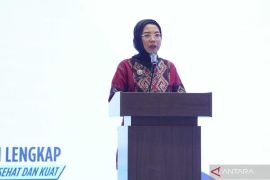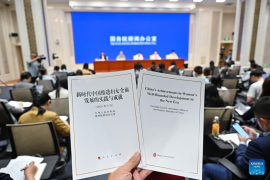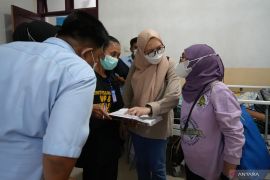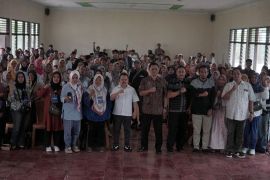SINGAPORE, May 16, 2016 - (Antara) - Research investigators in Singapore have developed a new high throughput method that identifies how ribonucleic acid (RNA) molecules come together in an unbiased and large-scale manner inside cells. Named SPLASH, or Sequencing of Psoralen Linked And Selected Hybrids, this newly-developed technique was used to describe the RNA network in human and yeast cells, its dynamics, and how the structural organisation impacts translation and decay processes in the cell.
The development was jointly led by Drs Wan Yue and Niranjan Nagarajan from A*STAR's Genome Institute of Singapore (GIS), and was published online on 12 May 2016 in Molecular Cell.
RNAs are key molecules that play important roles in regulating gene expression in a cell. While the scientific community has extensively studied how mini cellular machines such as proteins and chromatin fold and interact with each other over the past decades, lesser is known about how RNA come together to interact with itself or with other RNA molecules. This limitation prompted the team to come up with SPLASH to advance understanding of RNA interactions.
Dr Wan, co-lead author of the study and Junior Principal Investigator of Stem Cell & Regenerative Biology at the GIS said, "The cell is a complex machine; we need to understand the configuration of all its components to be able to engineer and/or repair it. RNA shapes and RNA interaction networks are key to cellular function. Depending on cellular needs, these dynamic interaction networks can be remodelled. Most importantly, targeting these networks could be a means to inhibit infectious organisms." Dr Wan received the prestigious Branco Weiss Fellowship in 2014 and the Young Scientist Award in 2015 for her work on antimicrobial resistance.
The method will allow the team to study the transcriptomes[1] of infectious organisms - including pathogenic bacteria, dengue and Zika viruses - to understand the way RNA shapes and networks in these genomes enable the infection of human cells by pathogens. It is hoped that these efforts in understanding microbial pathogenicity will contribute to new anti-microbials, anti-virals or vaccines against these pathogens.
"It is exciting to have a first comprehensive view of the RNA interactome and to capture its dynamics. We now have the tools to understand how RNA structural organization impacts disease and pathogen biology, with the eventual goal being to leverage this understanding for new drugs and antimicrobials," added Dr Nagarajan, the paper's co-lead author and Principal Investigator of Computational & Systems Biology at the GIS.
GIS Executive Director Prof Ng Huck Hui said, "Understanding RNA interaction networks and gene regulation is an area of intense interest for the scientific community. Prior to the development of SPLASH, few tools allowed researchers to delve deeper into this field of research. This method now opens the field to understand the dynamics of RNA interaction networks in diverse organisms. I am hopeful that it will help the community better understand how RNAs function in vivo and as a result, reap the benefits from their newly-gained insights."
[1] The transcriptome is the set of all RNA molecules in one cell or a population of cells.
NOTES:
The research findings described in this media release can be found in the scientific journal Molecular Cell, under the title, "In Vivo Mapping of Eukaryotic RNA Interactomes Reveals Principles of Higher-Order Organization and Regulation" by Jong Ghut Ashley Aw(1),(5), Yang Shen(2),(5), Andreas Wilm(2),(5), Miao Sun(2), Xin Ni Lim(1), Kum-Loong Boon(1), Sidika Tapsin(1), Yun-Shen Chan(1), Cheng-Peow Tan(1), Adelene Y.L. Sim(3), Tong Zhang(4), Teodorus Theo Susanto(1), Zhiyan Fu(2), Niranjan Nagarajan(2),*, and Yue Wan(1),*.
(1) Stem Cell and Regenerative Biology
(2) Computational and Systems Biology
Genome Institute of Singapore, A*STAR, Singapore 138672, Singapore
(3) Bioinformatics Institute, A*STAR, 30 Biopolis Street #07-01, Matrix 138671, Singapore
(4) Human Genetics, Genome Institute of Singapore, A*STAR, Singapore 138672, Singapore
(5) Co-first author
* Correspondence: nagarajann@gis.a-star.edu.sg (N.N.), wany@gis.a-star.edu.sg (Y.W.)
Full text of the Molecular Cell paper can be accessed online from: http://bit.ly/222Nv5A
IMAGE: http://bit.ly/1OqH18P
Source: A*STAR's Genome Institute of Singapore
Text: "RNA interactions can occur within a RNA molecule and between different RNAs. These interactions are captured in a global manner by the method Sequencing of Psoralen crosslinked, Ligated, and Selected Hybrids (SPLASH). mRNA-mRNA interactions are organised into interaction networks and reflect cellular compartmentalisation. These interactions can be dynamic and remodelled according to environmental factors (depicted as rain in the figure) such as differentiation."
About A*STAR's Genome Institute of Singapore (GIS)
The Genome Institute of Singapore (GIS) is an institute of the Agency for Science, Technology and Research (A*STAR). It has a global vision that seeks to use genomic sciences to achieve extraordinary improvements in human health and public prosperity. Established in 2000 as a centre for genomic discovery, the GIS will pursue the integration of technology, genetics and biology towards academic, economic and societal impact.
The key research areas at the GIS include Human Genetics, Infectious Diseases, Cancer Therapeutics and Stratified Oncology, Stem Cell and Regenerative Biology, Cancer Stem Cell Biology, Computational and Systems Biology, and Translational Research.
The genomics infrastructure at the GIS is utilised to train new scientific talent, to function as a bridge for academic and industrial research, and to explore scientific questions of high impact. For more information about GIS, please visit www.gis.a-star.edu.sg
About A*STAR
The Agency for Science, Technology and Research (A*STAR) is Singapore's lead public sector agency that spearheads economic oriented research to advance scientific discovery and develop innovative technology. Through open innovation, we collaborate with our partners in both the public and private sectors to benefit society.
As a Science and Technology Organisation, A*STAR bridges the gap between academia and industry. Our research creates economic growth and jobs for Singapore, and enhances lives by contributing to societal benefits such as improving outcomes in healthcare, urban living, and sustainability.
We play a key role in nurturing and developing a diversity of talent and leaders in our Agency and Research Institutes, the wider research community and industry. A*STAR oversees 18 biomedical sciences and physical sciences and engineering research entities primarily located in Biopolis and Fusionopolis. For more information on A*STAR, please visit www.a-star.edu.sg
Contact:
Joyce Ang
Senior Officer, Office of Corporate Communications
Genome Institute of Singapore, A*STAR
Tel: +65 6808 8101
Email: angjj@gis.a-star.edu.sg
Reporter: PR Wire
Editor: PR Wire
Copyright © ANTARA 2016











